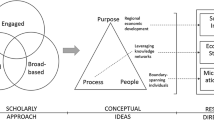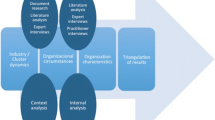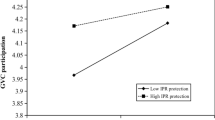Abstract
While there is growing interest in the division of entrepreneurial labor between MNEs and SMEs, most prior work focuses on empirical settings based within reputed clusters. To gain a more complete understanding of this phenomenon, we explore policy-induced efforts to facilitate MNE–SME collaboration for innovation in peripheral subnational regions (ones outside reputed clusters) in China and the UK. Our inductive study suggests that non-market actors’ intervention in the form of entrepreneurial boundary work entails three sub-processes: sensing, interfacing and co-creating. We find that boundary work manifests differently in advanced and emerging economies: as bottom–up opportunity discovery in the UK and top–down opportunity creation in China, with the former involving a bespoke policy measure and the latter a “bricolage” approach of making do with an existing generic policy that was creatively utilized. We thus shed useful light on how boundary work could connect previously unconnected innovation partners in different institutional contexts, and highlight the importance of integrative and innovative regional policies for promoting mutually beneficial MNE–SME collaboration.


Similar content being viewed by others
References
Alvarez, S. A., & Barney, J. B. 2007. Discovery and creation: Alternative theories of entrepreneurial action. Strategic Entrepreneurship Journal, 1(1–2): 11–26.
Archibugi, D., & Iammarino, S. 1999. The policy implications of the globalisation of innovation. Research Policy, 28(2–3): 317–336.
Arikan, A. T. 2009. Interfirm knowledge exchanges and the knowledge creation capability of clusters. Academy of Management Review, 34(4): 658–676.
Athreye, S. 2005. The Indian software industry and its evolving service capability. Industrial and Corporate Change, 14(3): 393–418.
Athreye, S., & Kapur, S. 2001. Private foreign investment in India: pain or panacea? World Economy, 24(3): 399–424.
Baker, T., & Nelson, R. E. 2005. Creating something from nothing: Resource construction through entrepreneurial bricolage. Administrative Science Quarterly, 50(3): 329–366.
Batjargal, B., Hitt, M. A., Tsui, A. S., Arregle, J.-L., Webb, J. W., & Miller, T. L. 2013. Institutional polycentrism, entrepreneurs’ social networks, and new venture growth. Academy of Management Journal, 56(4): 1024–1049.
Birkinshaw, J., Hood, N., & Young, S. 2005. Subsidiary entrepreneurship, internal and external competitive forces, and subsidiary performance. International Business Review, 14(2): 227–248.
Bouquet, C., & Birkinshaw, J. 2008. Managing power in the multinational corporation: How low-power actors gain influence. Journal of Management, 34(3): 477–508.
Buckley, P. J. 2018. Towards a theoretically-based global foreign direct investment policy regime. Journal of International Business Policy, 1(3–4): 184–207.
Buckley, P. J., & Prashantham, S. 2016. Global interfirm networks: The division of entrepreneurial labor between MNEs and SMEs. Academy of Management Perspectives, 30(1): 40–58.
Cano-Kollmann, M., Cantwell, J., Hannigan, T. J., Mudambi, R., & Song, J. 2016. Knowledge connectivity: An agenda for innovation research in international business. Journal of International Business Studies, 47(3): 255–262.
Cantwell, J. 2013. Blurred boundaries between firms, and new boundaries within (large multinational) firms: The impact of decentralized networks for innovation. Seoul Journal of Economics, 26(1): 1–32.
Cantwell, J., Dunning, J. H., & Lundan, S. M. 2010. An evolutionary approach to understanding international business activity: The co-evolution of MNEs and the institutional environment. Journal of International Business Studies, 41(4): 567–586.
Cantwell, J., & Mudambi, R. 2005. MNE competence-creating subsidiary mandates. Strategic Management Journal, 26(12): 1109–1128.
Cantwell, J. A., & Mudambi, R. 2011. Physical attraction and the geography of knowledge sourcing in multinational enterprises. Global Strategy Journal, 1(3–4): 206–232.
Crescenzi, R., & Iammarino, S. 2017. Global investments and regional development trajectories: The missing links. Regional Studies, 51(1): 97–115.
David, R. J., Sine, W. D., & Haveman, H. A. 2013. Seizing opportunity in emerging fields: How institutional entrepreneurs legitimated the professional form of management consulting. Organization Science, 24(2): 356–377.
Dimitratos, P., Liouka, I., Ross, D., & Young, S. 2009. The multinational enterprise and subsidiary evolution: Scotland since 1945. Business History, 51(3): 401–425.
Edmondson, A. C., & McManus, S. E. 2007. Methodological fit in management field research. Academy of Management Review, 32(4): 1246–1264.
Eisenhardt, K. M. 1989. Making fast strategic decisions in high-velocity environments. Academy of Management Journal, 32(3): 543–576.
Eisenhardt, K. M., & Graebner, M. E. 2007. Theory building from cases: Opportunities and challenges. Academy of Management Journal, 50(1): 25–32.
Enright, M. J. 2000. Regional clusters and multinational enterprises: Independence, dependence, or interdependence? International Studies of Management and Organization, 30(2): 114–138.
Ernst, D., & Kim, L. 2002. Global production networks, knowledge diffusion, and local capability formation. Research Policy, 31(8–9): 1417–1429.
Feldman, M., Francis, J., & Bercovitz, J. 2010. Creating a cluster while building a firm: Entrepreneurs and the formation of industrial clusters. Regional Studies, 39(1): 129–141.
Gereffi, G. 2019. Global value chains and international development policy: Bringing firms, networks and policy-engaged scholarship back in. Journal of International Business Policy, 2(3): 195–210.
Gieryn, T. F. 1983. Boundary-work and the demarcation of science from non-science: Strains and interests in professional ideologies of scientists. American Sociological Review, 48(6): 781–795.
Goerzen, A. 2018. Small firm boundary-spanning via bridging ties: Achieving international connectivity via cross-border inter-cluster alliances. Journal of International Management, 24(2): 153–164.
Iammarino, S. 2018. FDI and regional development policy. Journal of International Business Policy, 1(3–4): 157–183.
Iammarino, S., Rodriguez-Pose, A., & Storper, M. 2019. Regional inequality in Europe: Evidence, theory and policy implications. Journal of Economic Geography, 19(2): 273–298.
Khanna, T. 2008. Billions of entrepreneurs: How China and India are reshaping their futures and yours. Boston: Harvard Business Review Press.
Langley, A. 1999. Strategies for theorizing from process data. Academy of Management Review, 24(4): 691–710.
Leick, B., & Lang, T. 2018. Re-thinking non-core regions: Planning strategies and practices beyond growth. European Planning Studies, 26(2): 213–228.
Lorenzen, M., & Mudambi, R. 2013. Clusters, connectivity and catch-up: Bollywood and Bangalore in the global economy. Journal of Economic Geography, 13(3): 501–534.
Lundan, S. M. 2018. From the editor: Engaging international business scholars with public policy issues. Journal of International Business Policy, 1(1–2): 1–11.
Maskell, P. 2001. Knowledge creation and diffusion in geographic clusters. International Journal of Innovation Management, 05(02): 213–237.
McCann, P., & Acs, Z. J. 2011. Globalization: Countries, cities and multinationals. Regional Studies, 45(1): 17–32.
Monteiro, F., & Birkinshaw, J. 2017. The external knowledge sourcing process in multinational corporations. Strategic Management Journal, 38(2): 342–362.
Mudambi, R. 2018. Knowledge-intensive intangibles, spatial transaction costs, and the rise of populism. Journal of International Business Policy, 1(1–2): 44–52.
Mudambi, R., & Santangelo, G. D. 2016. From shallow resource pools to emerging clusters: The role of multinational enterprise subsidiaries in peripheral areas. Regional Studies, 50(12): 1965–1979.
O’Mahony, S., & Bechky, B. A. 2008. Boundary organizations: Enabling collaboration among unexpected allies. Administrative Science Quarterly, 53(3): 422–459.
Porter, M. E. 1998. Clusters and the new economics of competition. Boston: Harvard Business School Press.
Pouder, R., & St. John, C. H. 1996. Hot spots and blind spots: Geographical clusters of firms and innovation. Academy of Management Review, 21(4): 1192–1225.
Prashantham, S., & Birkinshaw, J. 2008. Dancing with gorillas: How small firms can effectively partner with multinational corporations. California Management Review, 51(1): 6–23.
Prashantham, S., & Birkinshaw, J. 2019. MNE-SME cooperation: An integrative framework. Journal of International Business Studies. https://doi.org/10.1057/s41267-019-00214-y.
Prashantham, S., Kumar, K., & Bhattacharyya, S. 2019. International new ventures from emerging economies: Network connectivity and legitimacy building. Management & Organization Review. https://doi.org/10.1017/mor.2019.22.
Prashantham, S., & Yip, G. S. 2017. Microsoft Starts Up, Strategy + Business, Issue 86 (Spring): 1–5.
Stovel, K., & Shaw, L. 2012. Brokerage. Annual Review of Sociology, 38: 139–158.
Strauss, A., & Corbin, J. M. 1990. Basics of qualitative research: Grounded theory procedures and techniques. London: Sage.
Suddaby, R., Bruton, G. D., & Si, S. X. 2015. Entrepreneurship through a qualitative lens: Insights on the construction and/or discovery of entrepreneurial opportunity. Journal of Business Venturing, 30(1): 1–10.
Szogs, A., Cummings, A., & Chaminade, C. 2011. Building systems of innovation in less developed countries: The role of intermediate organizations supporting interactions in Tanzania and El Salvador. Innovation and Development, 1(2): 283–302.
Tallman, S., Jenkins, M., Henry, N., & Pinch, S. 2004. Knowledge, clusters, and competitive advantage. Academy of Management Review, 29(2): 258–271.
Teece, D. J. 2007. Explicating dynamic capabilities: The nature and microfoundations of (sustainable) enterprise performance. Strategic Management Journal, 28(13): 1319–1350.
Tewdwr-Jones, M., & Phelps, N. A. 2000. Levelling the uneven playing field: Inward investment, interregional rivalry and the planning system. Regional Studies, 34(5): 429–440.
Troilo, M. L. 2014. Collaboration, product innovation, and sales: An empirical study of Chinese firms. Journal of Technology Management in China, 9(1): 37–55.
Turkina, E., & Van Assche, A. 2018. Global connectedness and local innovation in industrial clusters. Journal of International Business Studies, 49(6): 706–728.
Van Assche, A. 2018. From the editor: Steering a policy turn in international business—Opportunities and challenges. Journal of International Business Policy, 1(3–4): 117–127.
von Tunzelmann, N. 2009. Regional capabilities and industrial regeneration. In M. Farshchi, O. Janne, & P. McCann (Eds), Technological change and mature industrial regions: Firms, knowledge and policy: 11–28. Cheltenham: Edward Elgar.
Weiss, L. 2010. The state in the economy: Neoliberal or neoactivist? In J. Campbell, C. Crouch, P. H. Kristensen, G. Morgan, O. K. Pedersen, & R. Whitley (Eds), Oxford handbook of comparative institutional analysis. Oxford: Oxford University Press.
Yeung, H. W. C. 2009. Regional development and the competitive dynamics of global production networks: An East Asian perspective. Regional Studies, 43(3): 325–351.
Yin, R. K. 1994. Case study research, design and methods, 2nd ed. Newbury Park: Sage.
Young, S., Hood, N., & Peters, E. 1994. Multinational enterprises and regional economic development. Regional Studies, 28(7): 657–677.
Zahra, S. A. 2008. The virtuous cycle of discovery and creation of entrepreneurial opportunities. Strategic Entrepreneurship Journal, 2(3): 243–257.
Zietsma, C., & Lawrence, T. B. 2010. Institutional work in the transformation of an organizational field: The interplay of boundary work and practice work. Administrative Science Quarterly, 55(2): 189–221.
Acknowledgements
We thank Stephen Young for his collaboration on the UK study, Stella Yu for research assistance with the China study and Roy Suddaby for helping shape the ideas in this paper. The first author acknowledges generous support through a CEIBS research grant and NUBS China ORSS funding. Comments on earlier drafts from seminar participants at CEIBS and the University of Glasgow are appreciated. An earlier version of the paper was presented at the 2019 Academy of International Business Conference in Copenhagen, Denmark.
Author information
Authors and Affiliations
Corresponding author
Additional information
Publisher's Note
Springer Nature remains neutral with regard to jurisdictional claims in published maps and institutional affiliations.
Accepted by Suma Athreye, Area Editor, 20 September 2019. This article has been with the authors for one revision.
Rights and permissions
About this article
Cite this article
Prashantham, S., Bhattacharyya, S. MNE–SME co-innovation in peripheral regions. J Int Bus Policy 3, 134–153 (2020). https://doi.org/10.1057/s42214-019-00037-6
Received:
Revised:
Accepted:
Published:
Issue Date:
DOI: https://doi.org/10.1057/s42214-019-00037-6




